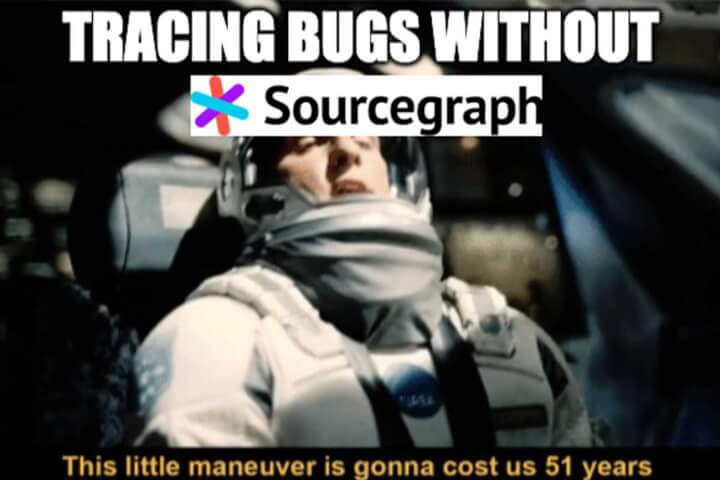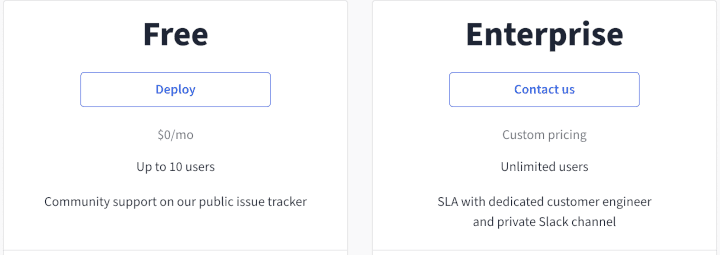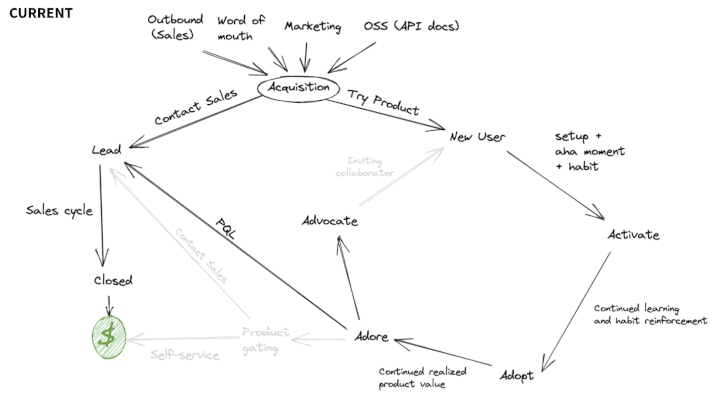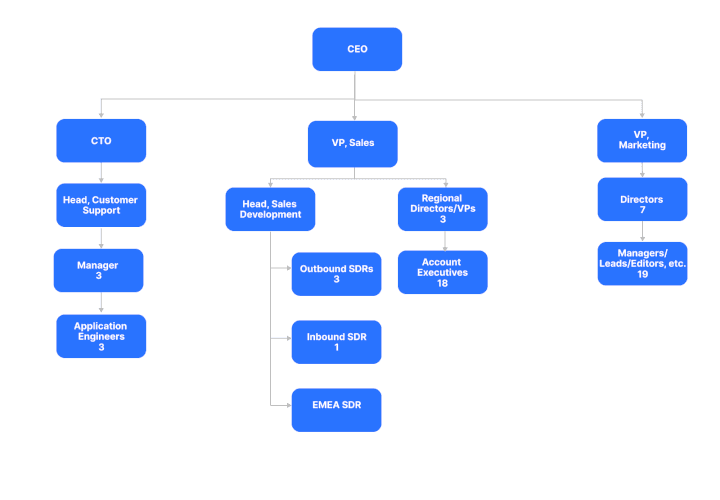Sourcegraph: Google for code
Sourcegraph: Google for code
Sourcegraph: Google for code
The growth levers and GTM strategies that powered the code-search platform to a 4x increase in revenue and a $2.625B valuation
The growth levers and GTM strategies that powered the code-search platform to a 4x increase in revenue and a $2.625B valuation
The growth levers and GTM strategies that powered the code-search platform to a 4x increase in revenue and a $2.625B valuation



Mark Andreessen was right. Software has eaten the world.
And now companies are drowning in code.
This is the age of Big Code and developers are dealing with hundreds of times the volume of code in their codebases compared to ten years ago. Every company is becoming a tech company, and an ever-diversifying product portfolio coupled with recent inconveniences caused by a bat means that along with sheer volume, the complexity of code has shot through the roof.
Earlier this year, a bug in the flight systems provided by Google took down the American, Delta, and United flight booking systems. Around 200 flights were canceled, and about the same number were delayed before the bug was found and fixed. In many companies today, lines of code written decades ago are still deployed in user-facing applications and are often barely holding massive Jenga blocks together.
Small codebases are a thing of the past, and the opensource explosion has compounded dependencies in the codebase, all of which developers must understand if they are to add to, debug or even recycle efficiently.
Quinn Slack and Beyang Liu were no exception. Being developers themselves, they both faced this very itch at Palantir, where they realized that a lot of code they were writing had either already been written by someone else at the company, or existed in an open-source library that they weren’t aware of.
Drowning in the inefficiencies of duplicated and dependent code, Quinn and Beyang set out to build something that developers like themselves could use to boost productivity by acting as a 'second brain'. They set out to build the equivalent of Google search, but for code.
Sourcegraph was built to reduce the redundancies that their CEO Quinn Slack and CTO Beyang Liu faced at Palantir. Fast forward to today, the "Google for code" is now valued at $2.625 billion on the back of their $150 million Series D funding in July 2021.
Today, a billion people are using products that were built by developers using Sourcegraph.
🌎 Bringing google code-search to the rest of the world
“If you meet a software engineer who works on the main google codebase and ask them what they think of google code search, they will tell you it is the best thing since sliced bread.” - Beyang Liu, CTO
Having worked at Google, Beyang Liu had used Google’s own internal code search before and seen the value that it delivered to developers. Beyang and Quinn wanted to bring this to the outside world for all code - both open-source and code within organizations. They wanted developers to be able to “stand on the shoulders of giants.”
Sourcegraph does this using srclib: the core analysis library that powers the code-search. The library works by graphing the underlying essence of code onto a language-agnostic schema, into which translators can be plugged depending on which language code is written in. Once the source code is graphed, the tool can understand code at a semantic level and is then able to jump to definitions globally, find references, and lookup documentation across all code - private or public.
With (1) code-search, developers can onboard to a new codebase, find answers faster, and identify security risks. With (2) batch changes, they can then keep their code up to date, fix critical security issues, and pay down tech debt across all of their repositories. The (3) code intelligence tool provides advanced code navigation features that let developers explore source code.
For a developer, using Sourcegraph extensions means that when a site is down and they get a call at 3 AM, Sourcegraph can point to the faulty code, tell them where else it is deployed, who last touched it, and show them all the error logs, reducing debugging time to minutes from hours.
"Just call it code-search!" Experimenting with positioning 🧑🔬
Within the first two weeks of their launch in 2013, Quinn and Beyang were using Sourcegraph to find code that someone had already written, to build... Sourcegraph. They were using Sourcegraph for Sourcegraph and already saving valuable time and effort. The advantages were immediately evident and they wanted to get the tool in the hands of every developer immediately.

The diaspora of developers who used and loved Sourcegraph advocated strongly for the tool. When they switched jobs and moved, especially from smaller companies to larger ones, they brought the tool with them to the new team of developers.
Ex-Google employees who always had the google internal code-search tool open in a tab every day sought out Sourcegraph as the natural replacement when they left Google and advocated its broader use at their new organizations. (Twitter's adoption of Sourcegraph with Scala support scaled through an engineer who had worked at Google before)
Before the pandemic, a developer could tap on someone's shoulder or go to lunch with them to understand a code library that predated their stint at the company. With all systems going remote, this void was now a huge opportunity that Sourcegraph could fill.
With all physical touchpoints moving online in the wake of the pandemic, companies had to now onboard thousands of developers into new roles very quickly, as they made increasingly larger bets on software and tech. Sourcegraph grew very very quickly during this time.
💵 Adding Sales to the flywheel
The first Sales teams at Sourcegraph were set up towards the end of 2019. Gregg Stone, who was head of US Sales at Segment was brought in as VP of Sales, along with Kacie Jenkins as VP of Marketing (previously at Fastly). Today, they're a team of ~20 under three regions: East, West, and International.
Here's the current Sourcegraph PLG flywheel, with Sales layered in:

Inbound and outbound SDRs identify leads for the AEs to set up meetings with if they fit the target opportunity profile:
Potential champion or coach that is aware of or understands code search in some capacity, probably from prior experience with Sourcegraph or another code search tool like OpenGrok or... has worked for Google/Facebook and used their tool
OR
Title/role includes developer productivity, developer experience, API services, distinguished eng, platform engineer, director+ eng
AND
Work at a company that has 50+ devs or a Commercial account (<250 employees)

🧘♂ Dev-happiness and the flow state
"Quinn and Beyang have been at it since 2013, fueled by their conviction that they could build the tool they needed as developers and by the mission that code search should be as universal as Google Search." - A16z blog
The Sourcegraphs founders want to put code-search in the hands of every developer in the world. They say that their biggest challenge isn't competition, it's that most developers haven't used code-search, and aren't aware of the value it adds.
Fresh from their Series D funding, they are hiring for 40+ open positions on their global all-remote team, aiming to scale companies of every size and scale.
Around 800,000 developers are using Sourcegraph today.
That number is going up every time you hit refresh.
Mark Andreessen was right. Software has eaten the world.
And now companies are drowning in code.
This is the age of Big Code and developers are dealing with hundreds of times the volume of code in their codebases compared to ten years ago. Every company is becoming a tech company, and an ever-diversifying product portfolio coupled with recent inconveniences caused by a bat means that along with sheer volume, the complexity of code has shot through the roof.
Earlier this year, a bug in the flight systems provided by Google took down the American, Delta, and United flight booking systems. Around 200 flights were canceled, and about the same number were delayed before the bug was found and fixed. In many companies today, lines of code written decades ago are still deployed in user-facing applications and are often barely holding massive Jenga blocks together.
Small codebases are a thing of the past, and the opensource explosion has compounded dependencies in the codebase, all of which developers must understand if they are to add to, debug or even recycle efficiently.
Quinn Slack and Beyang Liu were no exception. Being developers themselves, they both faced this very itch at Palantir, where they realized that a lot of code they were writing had either already been written by someone else at the company, or existed in an open-source library that they weren’t aware of.
Drowning in the inefficiencies of duplicated and dependent code, Quinn and Beyang set out to build something that developers like themselves could use to boost productivity by acting as a 'second brain'. They set out to build the equivalent of Google search, but for code.
Sourcegraph was built to reduce the redundancies that their CEO Quinn Slack and CTO Beyang Liu faced at Palantir. Fast forward to today, the "Google for code" is now valued at $2.625 billion on the back of their $150 million Series D funding in July 2021.
Today, a billion people are using products that were built by developers using Sourcegraph.
🌎 Bringing google code-search to the rest of the world
“If you meet a software engineer who works on the main google codebase and ask them what they think of google code search, they will tell you it is the best thing since sliced bread.” - Beyang Liu, CTO
Having worked at Google, Beyang Liu had used Google’s own internal code search before and seen the value that it delivered to developers. Beyang and Quinn wanted to bring this to the outside world for all code - both open-source and code within organizations. They wanted developers to be able to “stand on the shoulders of giants.”
Sourcegraph does this using srclib: the core analysis library that powers the code-search. The library works by graphing the underlying essence of code onto a language-agnostic schema, into which translators can be plugged depending on which language code is written in. Once the source code is graphed, the tool can understand code at a semantic level and is then able to jump to definitions globally, find references, and lookup documentation across all code - private or public.
With (1) code-search, developers can onboard to a new codebase, find answers faster, and identify security risks. With (2) batch changes, they can then keep their code up to date, fix critical security issues, and pay down tech debt across all of their repositories. The (3) code intelligence tool provides advanced code navigation features that let developers explore source code.
For a developer, using Sourcegraph extensions means that when a site is down and they get a call at 3 AM, Sourcegraph can point to the faulty code, tell them where else it is deployed, who last touched it, and show them all the error logs, reducing debugging time to minutes from hours.
"Just call it code-search!" Experimenting with positioning 🧑🔬
Within the first two weeks of their launch in 2013, Quinn and Beyang were using Sourcegraph to find code that someone had already written, to build... Sourcegraph. They were using Sourcegraph for Sourcegraph and already saving valuable time and effort. The advantages were immediately evident and they wanted to get the tool in the hands of every developer immediately.

The diaspora of developers who used and loved Sourcegraph advocated strongly for the tool. When they switched jobs and moved, especially from smaller companies to larger ones, they brought the tool with them to the new team of developers.
Ex-Google employees who always had the google internal code-search tool open in a tab every day sought out Sourcegraph as the natural replacement when they left Google and advocated its broader use at their new organizations. (Twitter's adoption of Sourcegraph with Scala support scaled through an engineer who had worked at Google before)
Before the pandemic, a developer could tap on someone's shoulder or go to lunch with them to understand a code library that predated their stint at the company. With all systems going remote, this void was now a huge opportunity that Sourcegraph could fill.
With all physical touchpoints moving online in the wake of the pandemic, companies had to now onboard thousands of developers into new roles very quickly, as they made increasingly larger bets on software and tech. Sourcegraph grew very very quickly during this time.
💵 Adding Sales to the flywheel
The first Sales teams at Sourcegraph were set up towards the end of 2019. Gregg Stone, who was head of US Sales at Segment was brought in as VP of Sales, along with Kacie Jenkins as VP of Marketing (previously at Fastly). Today, they're a team of ~20 under three regions: East, West, and International.
Here's the current Sourcegraph PLG flywheel, with Sales layered in:

Inbound and outbound SDRs identify leads for the AEs to set up meetings with if they fit the target opportunity profile:
Potential champion or coach that is aware of or understands code search in some capacity, probably from prior experience with Sourcegraph or another code search tool like OpenGrok or... has worked for Google/Facebook and used their tool
OR
Title/role includes developer productivity, developer experience, API services, distinguished eng, platform engineer, director+ eng
AND
Work at a company that has 50+ devs or a Commercial account (<250 employees)

🧘♂ Dev-happiness and the flow state
"Quinn and Beyang have been at it since 2013, fueled by their conviction that they could build the tool they needed as developers and by the mission that code search should be as universal as Google Search." - A16z blog
The Sourcegraphs founders want to put code-search in the hands of every developer in the world. They say that their biggest challenge isn't competition, it's that most developers haven't used code-search, and aren't aware of the value it adds.
Fresh from their Series D funding, they are hiring for 40+ open positions on their global all-remote team, aiming to scale companies of every size and scale.
Around 800,000 developers are using Sourcegraph today.
That number is going up every time you hit refresh.
Related Articles




Behavioral Retargeting: A Game-Changer in the Cookieless Era
Unlock the power of behavioral retargeting for the cookieless future! Learn how it personalizes ads & boosts conversions. #behavioralretargeting




All of Toplyne's 40+ Badges in the G2 Spring Reports
Our customers awarded us 40+ badges in G2's Summer Report 2024.




Unlocking the Full Potential of Google PMax Campaigns: Mastering Audience Selection to Double Your ROAS
Copyright © Toplyne Labs PTE Ltd. 2024
Copyright © Toplyne Labs PTE Ltd. 2024
Copyright © Toplyne Labs PTE Ltd. 2024
Copyright © Toplyne Labs PTE Ltd. 2024